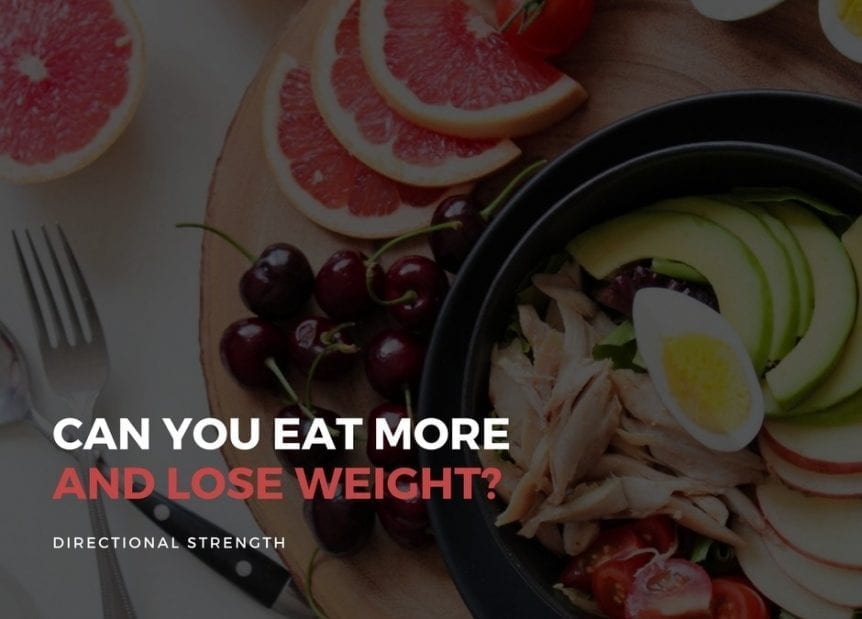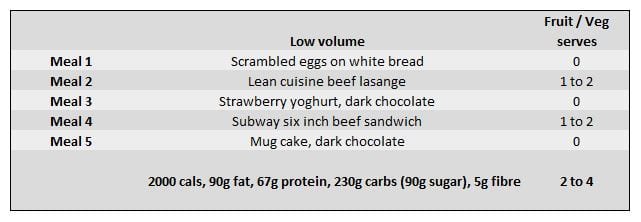Can you REALLY eat more food and lose more weight?
Well, yes.
And no.
As far as calories go, it’s impossible to eat more calories than we need and yet lose weight.
Anyone who tells you otherwise is lying to you or to themselves.
Typically, as we increase our calorie intake we experience an upward regulation of a number of thermogenic factors such as our level of activity, the amount of intensity we bring to the gym, our NEAT etc. So although it’s entirely possible that someone can increase their overall calorie intake and still be losing weight, it’s not true to imply that they have somehow overcome the laws of physics.
What MOST PEOPLE really mean when they say they are “eating more” is that the VOLUME of the food they are eating has increased. As in their plates are packed full of proteins, vegetables, fruit and other high volume, low calorie density foods. Therefore the total amount of food and the weight of the food which they are eating is higher.
This is logical, because lower calorie, high density foods are filling and they take up a lot of space. Vegetables and lean protein are the most filling foods we can eat, because they stretch the stomach, take longer to digest and their fibre content helps to create bulk and weight within their gastrointestinal journey.
Foods which are high in calories and lower in fibre will do the opposite – they occupy a smaller space as far as volume goes, but pack a larger punch when it comes to energy content. It is therefore easy to overeat and yet feel less satisfied when choosing packaged, processed and low nutrient dense options.
An example of how it works
Yesterday I tracked my total energy intake and the volume of the food I consumed.
I then compared my food choices to those which are similar, but less nutrient dense.
You’ll notice not just how much extra food I’m consuming, but also how many serves of fruit and vegetables I am getting and how the total calorie intake, macronutrient content and fibre content is favorable.
How the brain signals fullness
Our stomachs are connected to our brains via the vagus nerve, which is a column of receptors which transmit information back and forth between the two organs.
The stomach contains a series of mechanoreceptors, which are triggered when our stomachs experience a stretching sensation. We also have chemoreceptors which are triggered by the macronutrient content of foods, such as the amounts of fat, protein and carbohydrates which are contained in the meal – and these receptors signal the production of gastric juices, enzymes and other mechanisms which are responsible for the digestion process.
A variety of anorexigenic (anti-starvation) hormones are released, which stimulate digestion and signal to the hypothalamus via the vagus nerve that we are feeding. These are PYY, CCK, GLP-1, glucagon and amylin – and they are responsible for delaying the emptying of the stomach, increasing bile production and the secretion of hormones such as insulin and leptin.
Having a smaller stretching effect when eating because we are choosing energy dense, but not volume dense foods, can contribute to a lack of satiety and greater elevations and clearance of blood sugar. We also tend to consider high energy dense and low volume foods “rewarding” because they are typically high sugar, high fat combinations. Therefore we are more likely to return to consume them, than we are if we choose nutrient dense options.
How to “eat more” and lose weight
Eat more proteins, fruits, vegetables and low energy density foods most of the time.
You will feel fuller eating a higher volume of food that is lower in actual calories.



